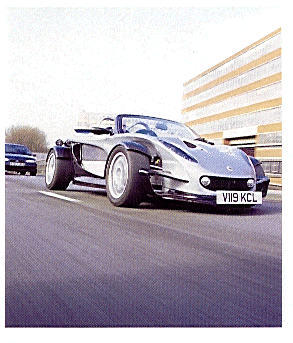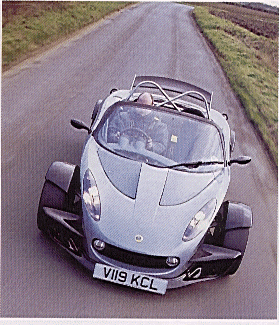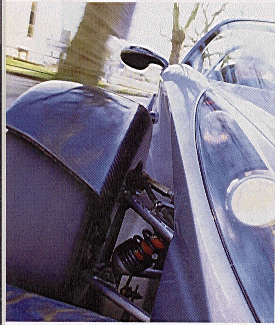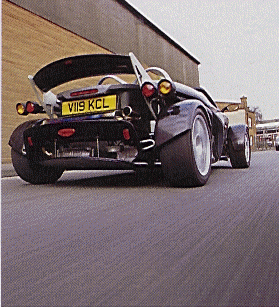Car Magazine - Road Test- April 2000 Issue
Forget if you can the attention grabbing looks. Forget the track-day appeal. What’s the Lotus 340R like on the road ? Breathtaking.
You’d think vision would be the last of its problems. In the Lotus 340R, you can see the sky above, the road below, your own wheels moving up and down. But you can't see too much behind you. The rollover structure puts a silver X in 144pt bold right across the rear-view mirror. But even that doesn't obscure your view of the road behind. No, it merely blocks out the rear spoiler. Somewhere beyond that is the wider world. And it's not as if you can turn your head and have a squint, because the four-point harness lashes you into the straight-ahead posture. But that's about all there is to make things difficult when you're mooning about in the everyday urban clog in this, the most extreme lightweight spider ever to have passed current full European whole vehicle type approval. It's extreme, but not silly.
This is, after all, a road car. It's also a part-time track day special but, of the 340 people out there who have secure orders, I can't imagine many managing to resist using it on the road. Not just for the proverbial Sunday morning cross-country recreational experience, but for the any-excuse hop to post a letter. After all, 60 grammes of printed matter fills the 340R's luggage capacity and doesn't do any harm to its power-to-weight ratio.
Three things distinguish the 340R from some of the other track-day specials on the market, most prominently the Caterham Superlight R500 and Westfield FW400. First, it's usable: fully certified - not just squeezed through low-volume or single-vehicle approval - and no great hassle in traffic. Why, it even has a windscreen and wipers. Second, it's designed, rather than merely shaped around its mechanicals. Some people (count me as one) get huge pleasure from this, but others will conclude this makes it a noncey poseurs' chariot. Finally, the 340R is not actually too mad on the road. It doesn't feel like a racing car displaced. It feels like a road car. Again, this will split opinion. It is not the most exciting car on the road, not if your definition of excitement means feeling like you've been strapped to a firework the size of a car. What the 340R brings is control, that exquisite feeling that the car is always working with you.
One of the most remarkable parts of the 340R’s makeup is how different it feels from the basic Elise. As we've covered before (CAR October 1999 and January 2000), the 340R uses an Elise platform - though it's even more rigid thanks to the fixed sides - and its suspension parts, engine and gearbox. The springs, dampers and bushings are naturally different, the wheels and tyres bigger and the engine is hopped up. Gearing is shared with the VVC engined Elise 111S, but the 177bhp 340R is tuned without the aid of VVC. That's the fully approved version, but I used one with the 190bhp pack for aftermarket use - MOT compliant but not type approved - which has a different inlet camshaft pulley for more overlap, a new chip and a huge, shiny silencer, a component that isn't particularly aptly named but does look extremely cool once you've given the engine a workout and its titanium coating turns a fetching shade of heat-treated rainbow blue.
Its performance up to about 4000rpm matches the VVC Elise's, presumably because the VVC apparatus is balanced by the weight reduction of the 340R. In other words, this is a swift device, its engine so responsive that it seems to get on the case before you've had time to flex your foot. But beyond that mid-rev theatre, the 340R runs harder than any Elise. It has that special acceleration reserved for low-inertia cars with revvy engines and close-stacked gears, a high-voltage jolt-shock propelling you forward. Don't think of that self-feeding speed of an airliner at take-off, because that describes the smoother and rangier acceleration that you get with supercars. This is a more intense scene of high-frequency gearshifts, fevered noise and a cyclone blowing around the back of your head. The tacho has closed-up numbers below 3000rpm, at which speed the exhaust rasps a rattly resonance, then spaces its numerals wider as they run to nine. During that passage upwards, a lion starts to roar from 4000, giving way to an increasingly fierce four-cylinder yelp until the tacho's red change-up light pops on at about 7600.
Despite its added lightness, at speed the 340R feels less delicate than the Elise. It's more rooted, more meaty at the wheel. No less agile, merely more serious. In an Elise, you hold the wheel lightly on a bumpy road, let it wriggle as the nose bobs slightly. In the 340R, there's more self-centring, a greater exactness as the car pursues a straight line more earnestly. Part of this comes from the larger-section tyres and greater roll stiffness, apart from the fact that both nose and tail have ruddy great multi-layer spoilers that suck the car downward and keep it straight. You can feel them, adding weight to the car's behaviour without adding mass.
No, mass is the last thing you're aware of as you turn the wheel. The water in the radiator is probably the heaviest thing ahead of your feet. Nothing but spoilers lurk behind the rear wheels, nothing's ahead of the fronts bar more spoilers and an energy-absorbing crash structure. And so the car doesn't so much turn as pivot about you.
Even without pushing the car, there's immense pleasure to be had from something so cut-back and unambiguous. It's like slicing with an ultra-honed knife: the satisfaction from the precision and case of it all never ends. But when you do what's actually the point, and push harder and faster, then the 340R goes to several new levels, digging a broad and deep trench across your senses. It's the combination of brutality and subtlety that does it, the way it can summon vast forces in the front-rear and left-right dimensions, and yet still telegraph through the wheel and seat an exquisitely nuanced picture of what's going on at the tyres.
Like any Lotus, it's a playable machine, so that when there's space you can trick its front-to-rear angles with the throttle, and then gather it up quickly with the biting-sharp steering. Also, like any Lotus, the feel is what makes this achievable, the fact that you can deploy that telepathy with the machine, its direction, its brakes, its mechanical doings, to worm your way up to a limit of grip that's mountainously high - in the dry, at least, thanks in part to the tyres' chewing-gum compound and cut-slick pattern. In the damp they still pass on a good portion of their friction and information, but when it's truly wet it takes but a tickle of throttle or an ill-conceived stab of brakes to get you skating.
But we haven't even got to the best bit yet. You see, this is a road car, and it rides like one. That's all very nice and comfy, but a smooth passage for its own sake is hardly the issue when you've already bent yourself so far out of shape just to be here. What matters is that the 340R has enough wheel travel and uncanny matching of spring suppleness to damping control that lets the car itself glide serenely along the course you've directed, while the wheels follow the road surface exactly. That translates as steady grip, secure traction and indomitable control when more track-bent sportsters simply hop from crest to crest.
If it were a closed coupe the 340R would be one of the great experiences (although it would be heavier and less wieldy, so the comparison's unfair). But factor in the openness and the intensity is wound up some more notches. The February wind is cold-scalding my face at speed, so my cheeks glow warm when I dawdle. When it rains, water pebbles hammer at my forehead until there's enough air speed to deflect them up and over. In the side mirrors I can see the rear mudguards moving up and down as the suspension does its job. Between the upper and lower aluminium side rails, the infill panel is frosted perspex, adding another fast-spooling blur to my peripheral vision.
And inside it's no less special. It's mostly non-Elise, too, even the big-shouldered race seats, the milled aluminium handbrake and the instrument set. There's none of the borrowed plastic switches in the Elise, but a row of aluminium dot-buttons arrayed down the central spar below the dash. Like the instruments, they're lit violet-blue, which is a bit of flim-flam - a delightful colour but one that's hard to focus on. To give you an idea of how basic this car is it might help to list every minor control. Key, starter button, stalk for lights and indicator, stalk for wiper, hazard switch between the instrument pods, lever for driver's seat slide, and buttons for trip-zero, side lights, headlights, electric screen defrost and rear fog. That's it. No heater, radio, window winders, seat recline, door handles or locks.
Sadly, the 340 doesn't just refer to the power-to-weight ratio - and actually only in track form, when the passenger seat, engine cladding, lights and front crashbox are chucked. It's also the number made, and Lotus is adamant there will be no more. It plans other extensions to the kingdom of Elise after this one's number is up, but it's hard to see how they can be better driving instruments. If you have a 340R order, you won't look back. Even if you could.
Copyright
CAR magazine April 2000



